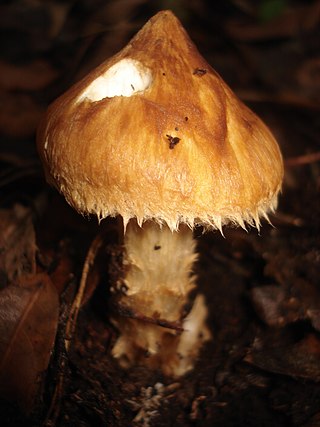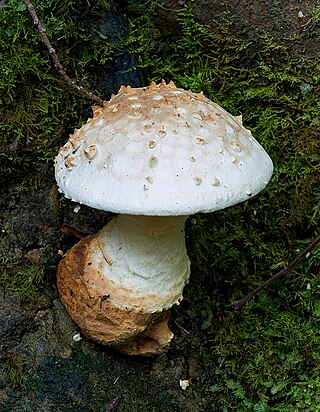Related Research Articles

The Parmeliaceae is a large and diverse family of Lecanoromycetes. With over 2700 species in 71 genera, it is the largest family of lichen-forming fungi. The most speciose genera in the family are the well-known groups: Xanthoparmelia, Usnea, Parmotrema, and Hypotrachyna.

Phallus indusiatus, commonly called the bamboo mushrooms, bamboo pith, long net stinkhorn, crinoline stinkhorn or veiled lady, is a fungus in the family Phallaceae, or stinkhorns. It has a cosmopolitan distribution in tropical areas, and is found in southern Asia, Africa, the Americas, and Australia, where it grows in woodlands and gardens in rich soil and well-rotted woody material. The fruit body of the fungus is characterised by a conical to bell-shaped cap on a stalk and a delicate lacy "skirt", or indusium, that hangs from beneath the cap and reaches nearly to the ground. First described scientifically in 1798 by French botanist Étienne Pierre Ventenat, the species has often been referred to a separate genus Dictyophora along with other Phallus species featuring an indusium. P. indusiatus can be distinguished from other similar species by differences in distribution, size, color, and indusium length.

Pleurotus is a genus of gilled mushrooms which includes one of the most widely eaten mushrooms, P. ostreatus. Species of Pleurotus may be called oyster, abalone, or tree mushrooms, and are some of the most commonly cultivated edible mushrooms in the world. Pleurotus fungi have also been used in mycoremediation of pollutants, such as petroleum and polycyclic aromatic hydrocarbons.

Littoraria is a genus of sea snails, marine gastropod mollusks in the family Littorinidae, the winkles or periwinkles.

The Phanerochaetaceae are a family of mostly crust fungi in the order Polyporales.
Lanspora is a genus of marine fungi in the family Phomatosporaceae. The genus was circumscribed in 1986 by mycologists Kevin D. Hyde and E.B. Gareth Jones with L. coronata as the type, and at that time, only species. Lanspora cylindrospora was added to the genus in 2020.

Cymatoderma is a widely distributed genus of poroid fungi in the family Meruliaceae.
Hymenagaricus is a genus of fungi in the family Agaricaceae. The widespread genus contains species found largely in tropical regions. Hymenagaricus was circumscribedby Belgian mycologist Paul Heinemann in 1981.
Agrogaster is a fungal genus in the family Bolbitiaceae. This is a monotypic genus, containing the single secotioid species Agrogaster coneae, described from New Zealand in 1986 by mycologist Derek Reid. The generic name Agrogaster combines "Agro", referring to the genus Agrocybe, and "gaster", alluding to its gasteroid nature.

Squamanita is a genus of parasitic fungi in the family Squamanitaceae. Basidiocarps superficially resemble normal agarics but emerge from parasitized fruit bodies of deformed host agarics.
Calathella is a genus of fungi in the mushroom family Marasmiaceae. According to the Dictionary of the Fungi, the genus contains nine species found in Europe and North America. The genus was circumscribed by the English mycologist Derek Reid in 1964.
Derek Agutter Reid was an English mycologist.
Bryocaulon is a genus of lichenized fungi in the family Parmeliaceae. The genus has a widespread distribution in north temperate regions, and contains three species. The genus was circumscribed by Swedish lichenologist Ingvar Kärnefelt in 1986.

Podoserpula is a genus of fungi in the family Amylocorticiaceae. The genus contains two species: the type, P. pusio, commonly known as the pagoda fungus, and the "Barbie pagoda", P. miranda, officially published in 2013. Podoserpula species produce fruit bodies consisting of up to a dozen caps arranged in overlapping shelves, attached to a central axis. Its unique shape is not known to exist in any other fungi. Four varieties of P. pusio are known, which differ in their sizes, spore morphology, and distribution. The genus is known to occur in Australia and New Zealand, Venezuela, Madagascar, and New Caledonia.

Amanita ochrophylloides is a large mushroom of the genus Amanita native to southeastern Australia.

Saproamanita nauseosa is a species of agaric fungus in the family Amanitaceae. First described by English mycologist Elsie Maud Wakefield in 1918 as a species of Lepiota, it was named for its nauseating odor. The type specimen was found growing on soil in the Nepenthes greenhouse at Kew Gardens. Derek Reid transferred the species to Amanita in 1966, and then in 2016 the separate genus Saproamanita was created by Redhead et al. for saprophytic Amanitas and it was transferred to this new genus.

The Irpicaceae are a family of mostly polypores and crust fungi in the order Polyporales.
References
- ↑ Kirk PM, Cannon PF, Minter DW, Stalpers JA (2008). Dictionary of the Fungi (10th ed.). Wallingford, UK: CAB International. p. 272. ISBN 978-0-85199-826-8.
- ↑ Reid DA. (1986). "New or interesting records of Australian Basidiomycetes". Transactions of the British Mycological Society. 86 (3): 429–40. doi:10.1016/S0007-1536(86)80186-3.